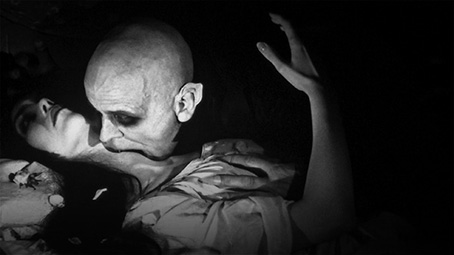The BFI's ongoing Gothic: The Dark Heart of Film project, which has already resulted in a number of splendid disc releases and special film screenings, and is continuing in a three-month long season of films at the BFI Southbank in London. If you're in town and fancy bathing in some of the best horror themed films from the first hundred years of cinema, then you should definitely check the season out.
The BFI's own introduction outlines the content and themes of the season:

Dracula and Frankenstein were transformed by film and television into towering myths. Vampires, werewolves, and the living dead rampaged through 20th-century culture, breaking taboos and upsetting the censors. But today monsters have become our heroes and our fairy tales are nightmares; young people are schooled in the Dark Arts at Hogwarts, and get their sentimental education from the undead.
The Gothic first gripped Britain in the 18th century. The novels of Horace Walpole and Ann Radcliffe set the parameters for the genre, putting brooding villains, imperilled heroines and religious excess centre-stage. However it was three later 19th-century works that defined the form: Mary Shelley’s Frankenstein, Bram Stoker’s Dracula, and Robert Louis Stevenson’s Strange Case of Dr Jekyll and Mr Hyde became film and TV’s sensational successes, setting a critically marginalised but subversive literary tradition at the heart of popular culture.
The great vitality of these stories lies in their forging of monstrous archetypes into profound modern fables about our fears and beliefs, struggles and torments. Beyond the characteristic Gothic atmosphere of gloom, it is these archetypes, drawing on the uncanny to express anxieties with reality, the limits of perception, and the nature of evil, which return to our screens, transforming to produce new sub-genres. Gothic is the mother of horror, but it is the mysteries of the past, the pleasures of the macabre, the psychological dimensions of fear, and what Coleridge termed 'desire with loathing strangely mix'd', that set the Gothic apart from her more visceral offspring.
The Dark Heart of Film explores Gothic film and television over four months, and across four themes – MONSTROUS, THE DARK ARTS, HAUNTED and LOVE IS A DEVIL – and highlights a range of sub-genres over 13 programme selections. Celluloid always fulfilled the most deep- rooted Gothic fantasies, conjuring ghostly forms, capturing spirits of the living, and re-animating the dead. The bravura style of German Expressionism, and the legendary horrors of Universal Studios and Hammer Films are celebrated here as part of a wider thematic exploration of Gothic film. Television’s embrace of the Gothic is just as vital, keeping fidelity to the literary classics through serial form and taking risks on haunting short stories. It was Buffy, after all, that really kick-started our present infatuation with the un-dead. Now a pervasive phenomenon across a bewildering range of media, the Gothic is everywhere. It’s Alive!
You can find full details of the films in the season and book tickets on-line at:
https://whatson.bfi.org.uk/Online/default.asp?BOparam::WScontent::loadArticle::permalink=gothic
|